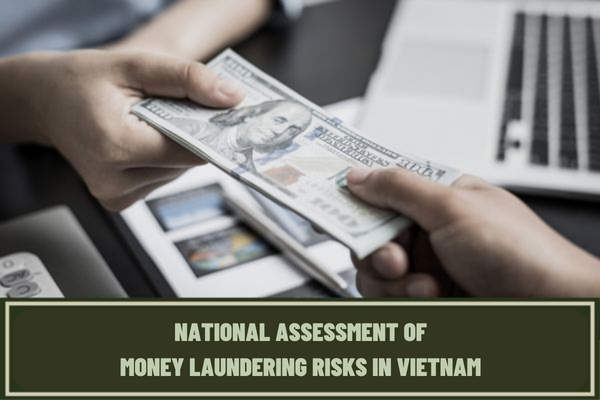What is the definition of money laundering according to the law? What are the criteria and methods for national assessment of money laundering risks in Vietnam?
- What is the definition of money laundering according to the law?
- What are the regulations on national assessment of money laundering risks in Vietnam?
- What are the criteria for national assessment of money laundering risks in Vietnam?
- What are the regulations on the methods of national assessment of money laundering risks in Vietnam?
What is the definition of money laundering according to the law?
Pursuant to Clause 1, Article 3 of the 2022 Law on Anti-Money Laundering in Vietnam, money laundering refers to the act that a natural or legal person performs to legalize the origin of the property derived from any offence(s).

What is the definition of money laundering according to the law? What are the criteria and methods for national assessment of money laundering risks in Vietnam? (Image from the internet)
What are the regulations on national assessment of money laundering risks in Vietnam?
Pursuant to Article 7 of the 2022 Law on Anti-Money Laundering in Vietnam, every 5 years, the State Bank of Vietnam shall lead and/or cooperate with Ministries and central authorities concerned in conducting the national assessment of money laundering and seeking the Government’s approval of assessment results and post-assessment action plans. The national assessment of money laundering shall cover all activities newly classified as sources of money laundering risk.
In addition, ministries and central authorities shall assume the following responsibilities:
- Widely disseminate the results of the national assessment of money laundering risks within their internal setting, and to the reporting entities placed under their jurisdiction, and also take measures to minimize the identified risks;
- Provide the State Bank of Vietnam with update on money laundering risks based on execution of post-assessment action plans, or whenever any risk arises within their remit. On the basis of the risk update results informed by these Ministries or central authorities, the State Bank of Vietnam shall integrate them into reports submitted to the Government to seek its approval of national money-laundering risk updates and action plans in response to these updated risks.
What are the criteria for national assessment of money laundering risks in Vietnam?
Pursuant to Article 4 of Decree No. 19/2023/ND-CP on the criteria for national assessment of money laundering risks are classified into the following subsets: money laundering risk; appropriateness of anti-money laundering policies and measures; and consequences of money laundering for the country, and sectors or industries. Specifically:
(1) The subset of money laundering risk criteria includes the following components: money laundering risk from sources of money laundering crime, and money laundering risk to sectors or industries, which are specifically described as follows:
- The component of money laundering risk from sources of money laundering crime is subdivided into money laundering risks specific to sources of domestic and transnational crime that are assessed;
- The component of money laundering risk to sectors and industries is subdivided into money laundering risks specific to domestic and transnational sectors or industries that are assessed.
(2) The subset of criteria of appropriateness of anti-money laundering policies and measures includes the following components: the comprehensiveness of legal framework and the effectiveness of law enforcement, which are specifically described as follows:
- The component of the comprehensiveness of legal framework is subdivided into the adequacy of anti-money laundering laws of the country and specific sectors or industries;
- The component of the effectiveness of law enforcement is subdivided into the effectiveness of enforcement of laws of the country; of sectors or industries; and the appropriateness of anti-money laundering policies and measures associated with a number of key products and services of these sectors or industries.
(3) The subset of consequences of money laundering, including:
- Adverse impacts of money laundering on the economy;
- Adverse impacts of money laundering on the financial system;
- Adverse impacts of money laundering on sectors and industries;
- Adverse impacts of money laundering on the society.
What are the regulations on the methods of national assessment of money laundering risks in Vietnam?
Pursuant to Article 5 of Decree No. 19/2023/ND-CP stipulating as follows:
Assessment methods
1. The scoring method is used in national assessment of money laundering risk.
2. According to the scoring method, a scoring toolkit shall be used to score each of the criteria mentioned in Article 4 of this Decree on a scale of 1 to 5 in the following specific manners:
a) For the subset of money laundering risk, the scores, including 5, 4, 3, 2, and 1, indicate the levels of risk, including high, fairly high, medium, fairly low, and low, respectively;
b) For the subset of appropriateness of anti-money laundering policies and measures, the scores, including 5, 4, 3, 2, and 1, indicate the levels of appropriateness, including low, fairly low, medium, fairly high, and high, respectively;
a) For the subset of consequences of money laundering, the scores, including 5, 4, 3, 2, and 1, indicate the levels of consequence, including high, fairly high, medium, fairly low, and low, respectively;
d) For the subset of national money laundering risk, the scores, including 5, 4, 3, 2, and 1, indicate the levels of national risk, including high, fairly high, medium, fairly low, and low, respectively.
3. Information, figures and data of national assessment of money laundering risk are specified in the Appendix to this Decree.
4. The State Bank of Vietnam shall provide a scoring toolkit conforming to international standards on prevention and combat of money laundering.
According to the above regulation, the scoring method is used in national assessment of money laundering risk.
According to the scoring method, a scoring toolkit shall be used to score each of the criteria mentioned above on a scale of 1 to 5.
LawNet
